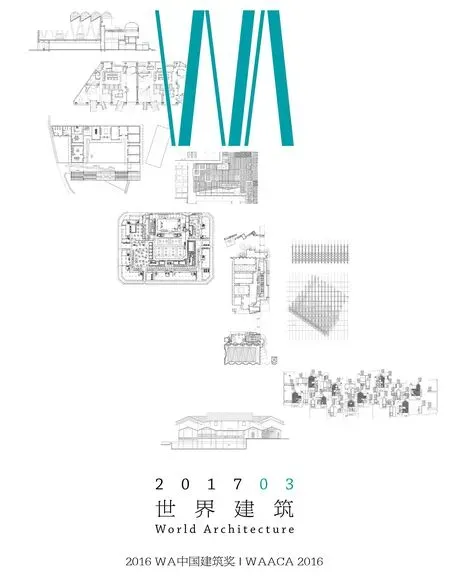前门西河沿街小蚂蚁皮影剧场,北京,中国
建筑设计:王辉/URBANUS都市实践
前门西河沿街小蚂蚁皮影剧场,北京,中国
建筑设计:王辉/URBANUS都市实践
这是一个位于北京大栅栏西河沿大街的公益设计项目。剧场的使用者是小蚂蚁皮影剧团,一个由生长素分泌缺乏症患者组织成的民间皮影演出和制作团体。
皮影作为一个传统的手工艺,有着迷人的镂空雕刻魅力。设计以镂空的皮影图案为视觉主题,放大到空间中,使皮影的主题跃然而出。这种图案被设计在4道悬梁上,形成了观众区的纵深感。悬梁在侧墙结合立板落地,构成一整面货架。而另一面墙的上半部则设计为通长的镜面,把窄空间放大了一倍。舞台设计成可旋转的,这样便可以在非放映时间打开去往后面工作间的通道。工作间只有2m宽,因此设计了一张曲线轮廓的桌子,满足了人员在两侧入座,同时师傅还可以置身桌面的中心来指导大家的工作。
这个公益项目得到了许多社会资源的支持和奉献。该设计力图用当下的设计理念,为一个特殊的残疾人群打造新的社会舞台。当建筑师号召大家为这个公益项目出力得到热烈反响,更证明了公益设计作为一种行为,释放出社会公平的正能量。□
项目信息/Credits and Data
客户/Client: 小蚂蚁皮影剧团/Little Ant Shadow Play Troupe
地点/Location: 北京市东城区西河沿大街147号/No. 147 Xiheyan Street, Beijing
主创建筑师/Principal Architect: 王辉/WANG Hui
设计团队/Project Team: 陈春,刘爽,曹淏铭,陈欣,崔婧/CHEN Chun, LIU Shuang, CAO Haoming, CHEN Xin, CUI Jing
照明设计/Lighting Design: 郑见伟,刘洋,黄雨璇,李国兴(郑见伟灯光设计工作室)/ZHENG Jianwei, LIU Yang, HUANG Yuxuan, LI Guoxing (Zheng Jianwei Lighting Design Studio)
建筑面积/Floor Area: 63m2
设计时间/Design Time: 2004.09
建成时间/Completion Time: 2014.09
摄影/Photos: 魏斌/WEI Bin



1 从胡同看皮影剧场/Watch the shadow play theater from Hutong2 总平面/Site plan3 入口/Entrance




4 内景/Interior view5 剧场吸引了胡同里过往的行人/Passersby attracted by the theater6 平面/Plan7 剖面/Section8 轴测图/Axonometric drawing
This is a public welfare project, located in Xiheyan Street, Beijing. The client is the Little Ant Shadow Play Troupe, constituted by patients of growth hormone secretion defciency.
As a traditional handicraft, shadow play uses intricate and detailed carvings to produce charming figures used for the play. The design exploits this characteristic of shadow play and applies the idea of detailed carvings into interior design. The beams combined with vertical carved boards extend to the ground on one sidewall, forming a big shelf. On the other hand, the upper half of the other sidewall was designed to be a full-length mirror, which enlarges the space two times its size. The stage was intended to rotate so that the passage to the workshop in the back would be open when no performances. Since the workshop is only two meters wide, a curvedprofile table was designed, not only allowing the staf sit on both sides, but also allowing the master to guide their work in center of desk.
This public welfare project was supported through the support and donations of many social resources. This design seeks to use contemporary design concept in order to create a new social stage for the disabled. The architect also received warm responses when he called on everyone to support this welfare project. It also verifies that welfare projects can help inspire positivity to the society.□



9.10 内景/Interior views11.12 制作间/Workshop

13 从观众区看舞台/Stage viewed from auditoria
评委评语
该项目的出色之处在于,建筑师以社会企业家的身份发起项目并为其筹集资金的前瞻性的方式。它是为一群患有生长素分泌缺乏症的皮影艺人设计的,他们经常被轻蔑地称为“小矮人”,这也影响了项目的尺度。这个在北京胡同里的皮影剧场不仅是一个满足一群皮影艺人特殊需求的设计,而且有效地实现了包容性。通过吸引公众来看演出,构建一个更广泛的认知和接受这个群体的社会环境。商店的立面设计极为通透,吸引观众走进剧场,也让人可以在街上清晰地看到内部独特的剪纸舞台布景。□
Jury Statement
What makes this a standout project is the proactive way that the architects initiated it and sought funding for it, acting as social entrepreneurs. It is designed for a group of puppeteers with Pituitary Stalk Interruption Syndrome (PSIS), a condition that impacts on size - they often pejoratively get referred to as the "Little People". The puppet theater, in a Hutong district of Beijing, is not only inclusive design, catering for the group of puppeteer's particular needs, but also efectively enables inclusivity; by attracting the public to its shows it builds a wider awareness and acceptance of the group's condition in society. The shop facade has been designed to be highly luminous and transparent, drawing audiences into the theater, and making the distinctive cutout stage-set like screens of the interior highly visible from the street.□
Little Ant Shadow Play Theater in Qianmen, Beijing, China, 2014
Architect: WANG Hui/URBANUS

